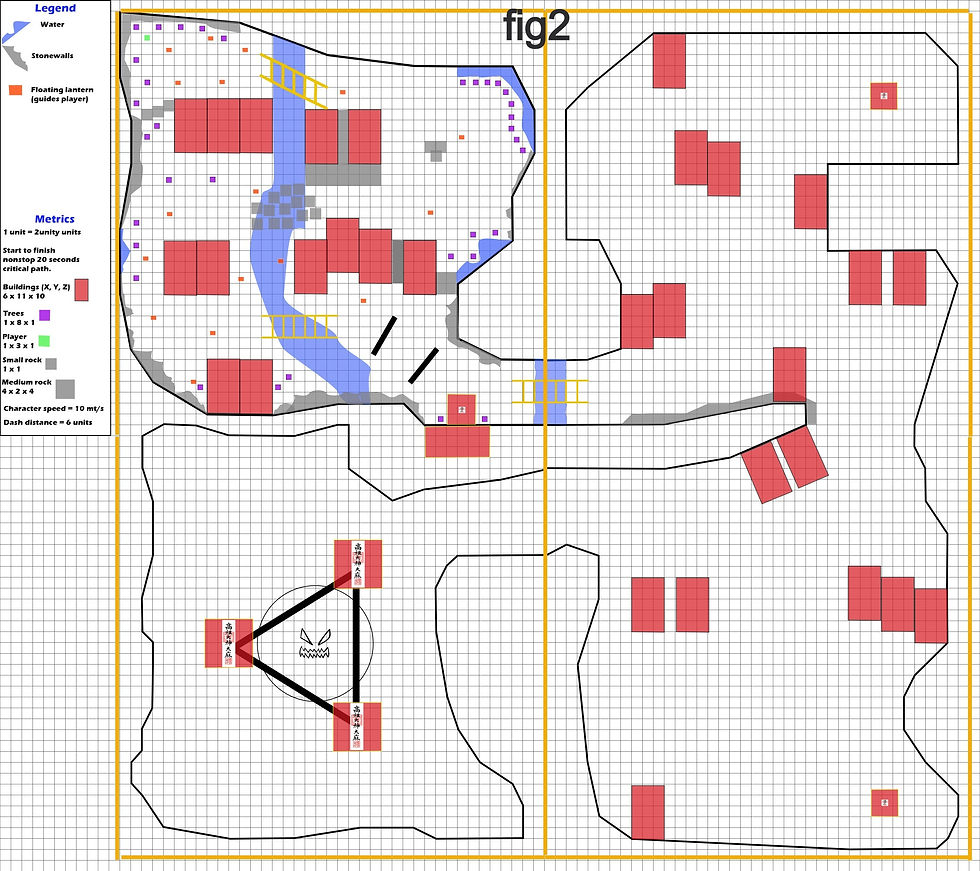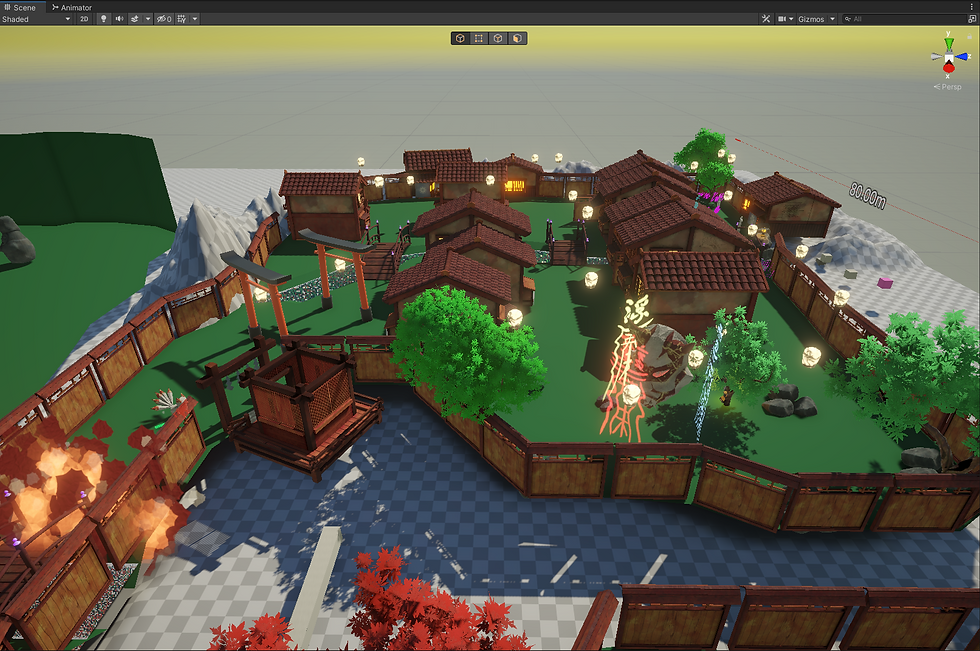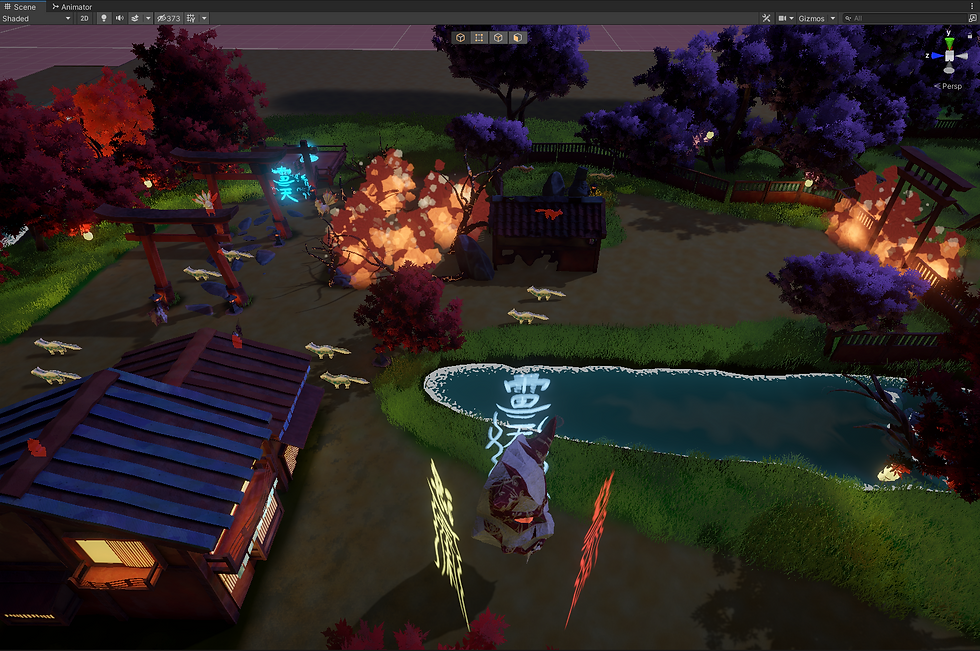Paper Samurai - VFS Final Project
- José Pablo Loza
- Nov 24, 2021
- 6 min read
Updated: Nov 28, 2023
Paper Samurai is a 3D isometric hack and slash PC game, where the player controls an agile, deadly but good-willed samurai made from washi paper who wields a washi katana as their main weapon. The game features a fantasy environment mixed with traditional Japanese architecture, Washi Paper demons as enemies, and a mysterious setting in one old samurai town. Throughout the game, the player must escape from the Great Demon, a large hovering Oni paper mask, while killing incoming smaller demons. To free the town from this evil, the player must find three ofuda seals scattered around that will power their sword allowing them to vanquish it.
Footage captured and trailer edited by: Jose Pablo Loza
Throughout this project I had the opportunity to face multiple responsibilities:
Project Management:
Nurtured a secure and encouraging professional atmosphere, upleveling the team to achieve and healthy work-life balance while fostering a fun environment that embraced every creative notion.
Guided and established well-defined objectives for team gatherings, ensuring that responsibilities and next steps were clear at the end of each meeting.
Effectively tracked project tasks and full development schedule using ClickUp, ensuring streamlined organization and providing a comprehensive view of the overall project status.
Game and Level Design:
Championed the design vision effectively conveying its core concepts, resulting in a team-wide excitement and commitment through all the development phases.
Iterated frequently in Photoshop 2D layouts and implmeneted in engine blockouts, integrating insights from A/B testing. This process was instrumental in establishing optimal level sizes, cohesive spaces, enemy placements and trigger locations.
Demonstrated a clear and effective game design workflow, indicating a clear understanding of the development process from concept to final implementation delivering one of the best demos in the class.
Defined the Core loop and overall game structure from ideation to creation paying close attention to cohesive and meaningful design decisions.
Constantly iterated on the game’s documentation streamlining notes from mentors, instructors and playtesters.
Gathered key reference to design and sell believable/cohesive spaces.
Gather key reference to design cohesive HUD, UI, and iconography using Adobe Illustrator.
Introduction
Given the time constraints and technical limitations, I had to consider an achievable approach. Not only that, but this school experience required me to wear multiple hats. I fulfilled the roles of Level Designer, Game Designer, Project Manager, and UI/UX Designer. It was tough! However, don't misunderstand me; I thoroughly enjoyed being involved in different departments and facing a diverse range of challenges. Moreover, I had the privilege of working with a wonderful team consisting of talented programmers, artists, and sound designers.
Through this brief analysis, I will specifically share my journey as a Level Designer and Game Designer. I will outline some of the obstacles I encountered during pre-production and production.

Design process
Before deciding on our project, each team member was tasked with brainstorming one or two ideas to pitch the following day. I began by establishing the core pillars of a game I wanted to create: action, agility, and power. The image of Japanese samurais quickly came to mind, representing a combination of swiftness and strength. After some contemplation and gathering references, I formulated a concise one-sentence statement that effectively conveyed my concept. It revolved around a Samurai being relentlessly pursued by a hovering demon, and their objective was to collect powerful items to fight back.
The next day, after hearing the other ideas and engaging in multiple brainstorming sessions, we conducted a vote and decided to develop Paper Samurai. With this project approved, I had to kick my creative gears into motion, as all I had was a vague one-sentence statement. I began asking myself several key questions: What is the primary conflict and objective of the game? How does the player go about achieving that objective? What are the main and secondary obstacles? What does the game world look like? Are there any existing games we can draw inspiration from?

Here are a couple key words and pictures of the reference gathering process prior to pitching the idea to my group.

Later in the process, as our idea became more defined, we gained a clearer understanding of what we were actually building. This newfound clarity instilled confidence in us and allowed us to embark on our tasks within our respective departments. As the project manager, I took the opportunity to plan and delegate tasks based on each individual's area of expertise.
Level Design
The first iterations were based on a linear and simple design where the player could have the chance of exploring the surroundings without necessarily getting lost. Additionally, I did some research on samurai towns and how they looked from a birds eye view, this was especially helpful for coming up with the inspiration of a linear and snake like design where the player could go easily from point A to point B and back. That is how I came up with the first draft of the initial area on the right, fig1.


With a solid foundation like this one it was time to establish the rest. I proceeded to design an approximate overall size of the game world. The image below, fig2, shows the earliest design in which we had at the bottom left quadrant a defense section. Here, the player had to capture the Great Demon between three pillars and survive incoming hordes of servants to win.

Later in development, we noticed that with the current scope and time constraints it was going to be impossible to properly design the mentioned area. Despite having a working prototype, the complexity of the mechanic and the introduction to a different set of gameplay required far more time.
I decided to remove the quadrant and adjust the design around a more simple and straightforward experience that fitted the 10 minute gameplay time requirement.
Fight through the enemies, while being chased by the Great Demon.
Collect the seals to get rid of the Great Demons immunity and power your sword.
Face off and vanquish the great evil.
After this decision the design ended up looking like this fig3. Three quadrants, a fixed critical path and some optional paths to let players explore this world.

I proceeded to whitebox and prototype the entire level inside Unity to start testing as soon as possible. This way I could gather information from approximately how long the playthrough was going to last, which areas were frequently visited and which weren't, also I identified if players were getting lost or had an easy time navigating.
In order to keep the team on the same page, it was quite useful to create a beat chart followed by a short description of each moment in the game. For this second task I integrated it to the 2D layout itself so whoever was reading it could picture the time and place of the event.
Once the design was inside Unity I was able to continuously polish it live with direct feedback from my peers and instructors until the last weeks of production.
Before and After
Below some screenshots of the different stages of the creation of the level.
Before

After 1.0

Final

Before

After

Metrics Gym

Metrics Gym

Entire Level First Iteration

Entire Level Iteration

Entire Level Final Version

Conclusion: After this 5 month journey we were able to ship Paper Samurai, the satisfaction of a published polished experience is immense. My biggest take-aways are being open minded to feedback, constant communication with the team and reference gathering. The first one allowed me to see my designs get "torn apart", in a good way of course, since I was able to identify the main flaws and had to think of ways to solve them. Moreover, communicating my designs to the rest of the team in a periodical manner was the key to success, everyone was able to catch something that wasn't too obvious from my perspective. This way I could jump in engine and adjust any relevant observations. I found this especially good when working with Dennis, the environment artist, since it allowed to us to create a more polished, cohesive and logical space. Lastly, reference gathering, this is immensely helpful not only to design believable fantasy, but to check other games that have similar functionality. This meant that 1. we could base our decisions on something that had already been successfully done and 2. Sometimes getting a point across is way easier if you have a reference handy.
Finally, thank you for taking the time and reading through this experience, have a great day!
Video: Highlights Paper Samurai



Comments